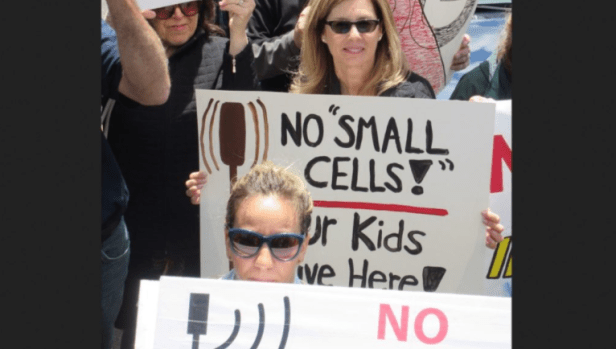T-Mobile and Crown Castle Sign 12-Year Agreement to Expand U.S. 5G Coverage via Macro Towers, Small Cells, and Fiber
Date: January 8, 2022Author: Nwo Report

Source: B.N. Frank
AT&T and Verizon agreed to delay their U.S. 5G expansion until January 19 due to increasing concerns about aviation safety risks. Of course, T-Mobile and Crown Castle have plans for 5G expansion too.
From RCR Wireless:
T-Mobile US inks deal with Crown Castle to expand 5G infrastructure
T-Mobile US and Crown Castle International have signed a new 12-year agreement to support the continued build-out of T-Mobile’s nationwide 5G network with increased access to Crown Castle’s towers and small cell locations.
Under the terms of the agreement, T-Mobile US will further expand the reach of 5G network to serve consumers across the U.S. while also realizing financial synergies following its merger. The agreement also helps Crown Castle generate long-term tower and small cell revenue growth.
Neville Ray, president of Technology at T-Mobile, said: “This agreement is another integral piece of T-Mobile’s ongoing efforts to rapidly expand what is already America’s largest 5G network. We won’t stop focusing on reaching even more customers and delivering fast 5G speeds to more people – every day and into the future.”
“We’re excited to build on our long-standing strategic relationship with T-Mobile as we work closely with them to continue to deploy their next-generation 5G network,” said Jay Brown, Crown Castle’s CEO. “T-Mobile and Crown Castle are ideal partners for this next phase as wireless network architecture continues to densify. We believe T-Mobile’s significant long-term commitment to utilize our comprehensive infrastructure consisting of towers, small cells and fiber will enable our collective teams to quickly meet future network demands.”
Crown Castle owns, operates and leases more than 40,000 cell towers and approximately 80,000 route miles of fiber supporting small cells and fiber solutions across every major U.S. market.
In a separate statement, T-Mobile said it ended 2021 with over 210 million people covered with its Ultra Capacity 5G service, which is based on standalone architecture, reaching over 80% of all T-Mobile customers, The carrier said it aims to reach 300 million people covered by this service by the end of 2023.
The telco said it has been executing a multi-band spectrum strategy that includes low-band Extended Range 5G which reaches over 310 million Americans and is expected to cover 99% of Americans by 2023.
“Our 5G leadership continues to be unrivaled on every level. We are crushing our network build out goals. Our nationwide Ultra Capacity 5G and our Extended Range 5G expansion is way ahead of schedule and we aren’t slowing down. We’re way out ahead of the pack today creating the foundation for transformational 5G experiences that will define the future for years to come and consumers will benefit,” said Mike Sievert, T-Mobile CEO.
T-Mobile’s merger with Sprint in 2019 led the way for T-Mobile to use Sprint’s licensed 2.5 GHz spectrum and previously licensed 600MHz spectrum to roll out its standalone 5G network in 2019. By the summer of 2020, T-Mobile claimed to deploy the world’s first nationwide 5G SA network.
American opposition to 5G deployment has been ongoing for years due to various significant risks associated with it.
In addition to aviation safety risks, other considerable risks associated with 5G include
- Cybersecurity risks (see 1, 2, 3, 4)
- Environmental risks (see 1, 2, 3, 4, 5, 6)
- Health risks (see 1, 2, 3, 4, 5)
- Privacy risks (see 1, 2, 3)
- Weather forecasting satellite interference risks
- Utility infrastructure interference risks
Studies have also determined that 4G is still better, more reliable, and safer than 5G (see 1, 2, 3, 4, 5, 6, 7).
Opposition to 5G is worldwide. This has slowed and/or stopped 5G deployment in some places. Since 2017 doctors and scientists have asked for moratoriums on Earth and in space (see 1, 2) and the majority of scientists oppose deployment. Since 2018 there have been reports of people and animals experiencing symptoms and illnesses after 5G was activated (see 1. 2, 3, 4). Some blame COVID-19 on 5G deployment while others do not. Regardless, research has determined that there are health risks associated with 5G exposure as well as exposure to 4G and other sources of wireless Wi-Fi radiation (see 1, 2) and Electromagnetic Fields (aka “Electrosmog”). In fact, American firefighter unions have been opposed to the use of their stations for cell towers and antennas since before 5G and 4G.
https://youtu.be/OZe2XnqomIc
MORE HERE: https://nworeport.me/2022/01/08/t-mobile-and-crown-castle-sign-12-year-agreement-to-expand-u-s-5g-coverage-via-macro-towers-small-cells-and-fiber/
Thanks to: https://nworeport.me
Related posts:
Views: 0
 RSS Feed
RSS Feed

















 January 9th, 2022
January 9th, 2022  Awake Goy
Awake Goy 



 Posted in
Posted in  Tags:
Tags: 
















